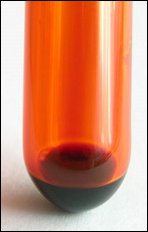| General Chemistry is a free introductory textbook on chemistry. See the editorial for more information.... |

|

Home  Chemical Elements Chemical Elements  Halogens Halogens  Bromine Bromine |
|||||||||||||||||||
| See also: Periodic Table of the Elements | |||||||||||||||||||






|
|||||||||||||||||||
BromineAuthor: Robert Husted, Mollie Boorman
History(Gr. bromos: stench) Discovered by Balard in 1826, but not prepared in quantity until 1860. SourcesA member of the halogen group, bromine is obtained from natural brines from wells in Michigan and Arkansas. Some bromine is extracted today from seawater, which contains only about 85 ppm. Properties
ProductionMuch of the bromine output in the U.S. was used in the production of ethylene dibromide, a lead scavenger used in making gasoline anti-knock compounds. Lead in gasoline, however, has been drastically reduced due to environmental considerations. This will greatly affect future production of bromine. UsesBromine is used in making fumigants, flameproofing agents, water purification compounds, dyes, medicines, sanitizers, inorganic bromides for photography, etc. Organic bromides are also important.
|
|||||||||||||||||||
Home  Chemical Elements Chemical Elements  Halogens Halogens  Bromine Bromine |
|||||||||||||||||||
Last Update: 2011-02-16


